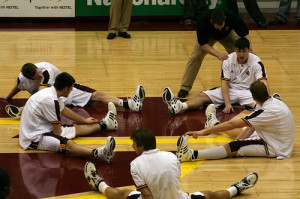Four Things to Make your Team Warm-up Better
Every coach has to have a team Warm-up and cool-down. With modern developments into sports research training techniques the warm-up is one of the most discussed elements of any training session. For many coaches this period of time however tends to be like a room for rent; great to have but doesn’t really fulfill anything of significance.
Here at Functional Basketball Coaching we see a number of different strategies utilised by coaches and we would like to highlight some of the better ones as well as give you some food for thought on how to get the most out of your team warm-up.
At elite and college level where coaches are able to work with athletes, day in and day out they can allow their players to conduct their own individual warm-up prior to the team training session starting. The great part about this strategy is that players can have a warm-up specifically designed for them. So players can perform activities that focus on their individual injury prevention needs or develop a technical skill series. Another option is to have player’s warm-up in small groups specific to their playing positions or a technical or tactical skill they are currently working on. For instance you might have your centres warm-up up together and through a series of drills concluding in a two on two drills focusing on high/low passing in the key.
At a junior level due to the maturity of your athletes and also to the increased duty of care you might not be able to be so free with sharing the responsibility with your players with regards to completing an acceptable warm-up that meets the inherent standards needed for playing basketball. This does not mean however you cannot delegate some responsibility, but ultimately when dealing with children and adolescents the buck always stops with the coach when considering their personal safety.
So here are five points that will ensure your team warm-up achieves the most it possibly can for your teams physiological, technical and tactical development.
-

A team Warm-up should prepare players for the challenges ahead. It is a time of mental and physical transition from off the court to on the court (Photo Source: Terry Johnston) Everyone should have a Role: Team Manager, Coaches and Players should all have a part to play in the team warm-up. A common issue is the training session once it starts is exclusively the domain of the Head Coach. This model of doing things while ensuring a consistent standard does not help draw upon the full potential of each person within the team. Examples could include having a player not already responsible for another task being the Warm-up Captain/Leader. Assistant Coaches can be responsible for certain activities within the team warm-up.
- Graduate the Warm-up Activities Intensity: This seems like an obvious point but you can do complex activities within your warm-up (not just court runs) as long as you control and monitor the level of intensity your players perform these at. Low intensity with high repetitions, leading to moderate intensity and finishing with high intensity.
- Sports Specific Drills can be Included into your Warm-up: It is alright to include technical and tactical drills into your team warm-up. The key is intensity as mention previously. You can utilise the fifteen to thirty minutes of warm-up activities to achieve objectives within your training session that help your teams development just the same as any other stage of the training session. The suggestion when starting out with low intensity technical skill drills focus on the performance of the skill being perfect because you are not focusing on performance at pace additional expectations can be placed upon the athletes.
- Variety Keeps Players Alert and Responsive: Not player, junior or senior enjoys the same repetitions over and over again, day after day, week after week. By changing what you do in your training sessions regularly it will help your team remain mentally fresh as well as providing an opportunity for you as a coach to focus on different skill sets within the team warm-up. Maybe work the team together for one week and in breaking athletes into playing positions (with Assistant Coaches supervising groups) every second week.
Finally keep reading; the area of sports science and human movement studies is constantly evolving. Every year there are new advancements in what provides benefit to help utilise this time even further and also to better meet the needs of the players under your direction. Even as a senior coach who has additional support like Strength and Conditioning Coach you should still update your knowledge so you can monitor your program effectively.








Leave a Reply